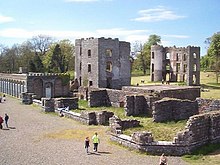
County Antrim is one of the six counties of Northern Ireland, located within the historic province of Ulster. Adjoined to the north-east shore of Lough Neagh, the county covers an area of 3,086 square kilometres (1,192 sq mi) and has a population of 651,321, as of the 2021 census. County Antrim has a population density of 211 people per square kilometre or 546 people per square mile. It is also one of the thirty-two traditional counties of Ireland.

County Down is one of the six counties of Northern Ireland, one of the nine counties of Ulster and one of the traditional thirty-two counties of Ireland. It covers an area of 961 sq mi (2,490 km2) and has a population of 552,261. It borders County Antrim to the north, the Irish Sea to the east, County Armagh to the west, and County Louth across Carlingford Lough to the southwest.

Lough Neagh is a freshwater lake in Northern Ireland and is the largest lake on the island of Ireland and in the United Kingdom. It has a surface area of 151 square miles and is about 19 miles (31 km) long and 9 miles (14 km) wide. According to Northern Ireland Water, it supplies 40.7% of Northern Ireland's drinking water. Its main inflows are the Upper River Bann and Blackwater, and its main outflow is the Lower Bann. There are several small islands, including Ram's Island, Coney Island and Derrywarragh Island. The lake bed is owned by the 12th Earl of Shaftesbury and the lake is managed by Lough Neagh Partnership. Its name comes from Irish Loch nEachach, meaning "Eachaidh's lake".
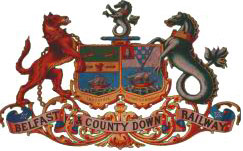
The Belfast and County Down Railway (BCDR) was an Irish gauge railway in Ireland linking Belfast with County Down. It was built in the 19th century and absorbed into the Ulster Transport Authority in 1948. All but the line between Belfast and Bangor was closed in the 1950s, although some of it has been restored near Downpatrick by a heritage line, the Downpatrick and County Down Railway.

The Giant's Causeway and Bushmills Railway (GC&BR) is a 3 ft narrow gauge heritage railway operating between the Giant's Causeway and Bushmills on the coast of County Antrim, Northern Ireland. The line is two miles (3.2 km) long.

Antrim is a town and civil parish in County Antrim in the northeast of Northern Ireland, on the banks of the Six Mile Water, on the northeast shore of Lough Neagh. It had a population of 25,606 people in the 2021 Census. It is the county town of County Antrim and was the administrative centre of Antrim Borough Council until its 2015 merger with Newtownabbey Borough Council to form Antrim and Newtownabbey Borough Council. It is 22 miles (35 km) northwest of Belfast.

Magheramorne is a hamlet in County Antrim, Northern Ireland. It is about 5 miles south of Larne on the shores of Larne Lough. It had a population of 75 people in the 2001 Census. Following the reform of Northern Ireland's local government system on 1 April 2015, Magheramorne lies within the Mid and East Antrim Borough Council area.

Belfast Castle is a mansion located in Cave Hill Country Park in Belfast, Northern Ireland, in a prominent position 400 feet (120 m) above sea level. Its location provides unobstructed views over the City of Belfast and Belfast Lough. There have been several different structures called "Belfast Castle" over the centuries, located on different sites. The current "castle" is a Victorian structure, built between 1867 and 1870 on the slopes of Cave Hill, and is Grade A listed. The main entrance into the Belfast Castle Demesne is now where Innisfayle Park meets Downview Park West, just off the Antrim Road. The original main entrance into the current demesne was formerly on the Antrim Road itself, where Strathmore Park now meets the Antrim Road.

Stewartstown is a village in Northern Ireland, close to the western shore of Lough Neagh, about 5 miles (8 km) from Cookstown, 3 miles (5 km) from Coalisland and 7 miles (11 km) from Dungannon. Established by Scottish Planters early in the 17th century, its population peaked before the Great Famine of the 1840s at over 1000. In the 2011 Census the town had a population of 650 people. Formerly in the historic County Tyrone, today it is in local-government district of Mid Ulster.

Clandeboye or Clannaboy was a kingdom of Gaelic Ireland, comprising what is now south County Antrim, north County Down, and the barony of Loughinsholin. The entity was relatively late in appearance and is associated partly with the Gaelic resurgence of the High Middle Ages. The O'Neill Clandeboy who reigned in the territory descended from Hugh Boy O'Neill, a king of Tyrone. His descendants took advantage of the demise of the Earldom of Ulster during the latter 14th century and seized vast portions of territory. Clandeboye's main seats of power were Shane's Castle and Castle Reagh.

The A6 road in Northern Ireland runs for 71.4 miles (114.9 km) from Belfast to Derry, via County Antrim and County Londonderry. While stretches of the road before Randalstown have now been superseded by a motorway, the A6 remains one of the most important arterial routes in Northern Ireland, connecting its two largest cities and urban areas. Between Randalstown and Derry, the road forms part of European route E16.

Lough Beg is a small freshwater lake north of Lough Neagh in Northern Ireland. The lake is located on the border between County Londonderry and County Antrim. The Lower Bann flows into it from Lough Neagh at the southern end and continues on its route to the sea from the northern end. Church Island which is on the lake was the site of a pre-Viking monastery and during the summer it is normally reachable by foot. Due to the area's many rare plants and it being a stopping point for migrating birds the area was protected as the Lough Beg National Nature Reserve. It is one of the main Irish breeding areas for the scarce Garganey.
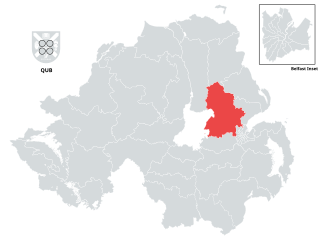
Antrim, sometimes known as Antrim Borough to distinguish it from the former constituency of the same name, was a single-member county constituency of the Parliament of Northern Ireland.

The Ballymena and Larne Railway was a 3 ft narrow gauge railway in County Antrim, Northern Ireland. The first part opened in July 1877 and regular passenger services began in August 1878, the first on the Irish 3 ft gauge railways. Passenger services ended in 1933 and the last part of the railway closed in 1950.

Randalstown is a townland and small town in County Antrim, Northern Ireland, between Antrim and Toome. It has a very prominent disused railway viaduct and lies beside Lough Neagh and the Shane's Castle estate. The town is bypassed by the M22 motorway with junctions at both the eastern and western ends of the town. It had a population of 5,151 people in the 2021 Census.
Sir Brian McPhelim Bacagh O'Neill was Chief of the Name of Clan O'Neill Lower Clandeboye, an Irish clan in north-eastern Ireland during the Tudor conquest of Ireland.
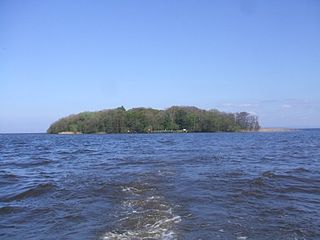
Coney Island is an island in Lough Neagh, Northern Ireland. It is about 1 km offshore from Maghery in County Armagh, is thickly wooded and of nearly 9 acres (36,000 m2) in area. It lies between the mouths of the River Blackwater and the River Bann in the south-west corner of Lough Neagh. Boat trips to the island are available at weekends from Maghery Country Park or Kinnego Marina. The island is owned by the National Trust and managed on their behalf by Armagh City, Banbridge and Craigavon Borough Council. Coney Island Flat is a rocky outcrop adjacent to the island. Although Samuel Lewis called Coney Island the only island in County Armagh, Armagh's section of Lough Neagh also includes Croaghan Island, as well as the marginal cases of Padian and Derrywarragh Island.
Ballyscullion House refers to two country houses built for the Hervey family near Bellaghy in County Londonderry, Northern Ireland, close to Lough Beg at north-west corner of Lough Neagh.
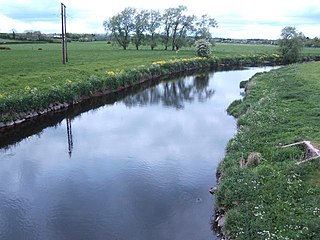
The River Main or Maine is a river in Northern Ireland, flowing through County Antrim.
Niall Mór O'Neill was a lord of Clandeboye in medieval Ireland. He succeeded his father, Conn O'Neill, to the lordship after his death in 1482. He reigned until his own death in 1512, after which he was succeeded by his son Hugh O'Neill. O'Neill's nickname Mór meant "great".
